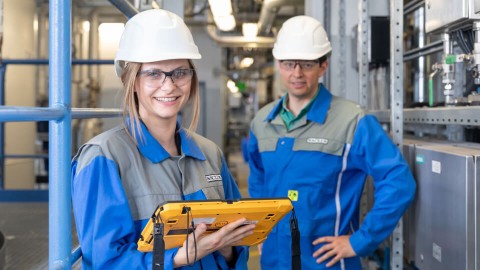ELASTOSIL® SOLAR 2200 A/B

ELASTOSIL® SOLAR 2200 A/B is a pourable addition curing RTV-2 silicone rubber for the lamination and encapslation of flexible thin-film solar modules. The product vulcanizes under heat to yield a flexible silicone rubber of medium hardness and with primerless adhesion to typical substrates.
Cured ELASTOSIL® SOLAR 2200 A/B shows long term stability against weathering, moisture and sunlight. The silicone
rubber may continously be exposed to constantly changing climatic conditions, UV radiation and temperatures as high
as 180 °C (356 °F) without damage.
Properties
Uncured:
- 1:1 mixing ratio
- Low viscosity
- Suitable for transfer roller or knife coating processes
- Fast cure at elevated temperature (≥120 °C)
Cured:
- Primerless adhesion to glass, aluminium, PET, PEN and primed ETFE films
- Good transparency
- Excellent resistance to sunlight
- Recommended service temperature range: -50 °C to +180 °C
Specific features of ELASTOSIL® SOLAR 2200 A/B
- Addition Curing
- Fast curing under heat
- Two-component
- UV stable
Data sheets
- Encapsulation of solar cells
- Roll-to-roll lamination of flexible solar modules
Caution! Only A and B components with the same batch number should be processed together!
Surface preparation:
All surfaces must be clean and free of contaminants that will inhibit the cure of ELASTOSIL® SOLAR 2200 A/B. Examples of inhibiting contaminants are sulfur containing materials, plasticizers, urethanes, amine containing materials and organometallic compounds – especially organotin compounds. If a substrate’s ability to inhibit cure is unknown, a small scale test should be run to determine compatibility.
Mixing:
Important! Component A of ELASTOSIL® SOLAR 2200 A/B contains the platinum catalyst, component B the crosslinker. Since even traces of platinum catalyst may cause gelling of component B, all tools (e.g. spatula, stirrers, mixing cups etc.) used for handling either component A or the A/B mix must not come into contact with component B by mistake.
The two components should be thoroughly mixed at a 1 : 1 ratio by weight or volume, preferably by automatic metering lines equipped with static or dynamic mixing devices.
Note: silicones absorb notable amounts of air, which can cause blistered vulcanizates. It is therefore recommended to de-aerate either component A and B individually, or the A/B mix, prior to application (recommended pressure settings: 25-50 mbar for 10-15 min.).
Material application:
The ELASTOSIL® SOLAR 2200 A/B mix can be applied to the respective substrate film either by knife coating or by a transfer roller coating process. Due to the silicone rubber’s long pot life after mixing, screen printing or transfer pad printing is also possible. Optimal bonding strength is achieved when the silicone layer has a thickness of 100 to 500 µm.
Lamination and curing:
After the coating process the substrate film is covered, e.g. with a protective front film, followed by heat-curing the ELASTOSIL® SOLAR 2200 A/B interlayer. In order to ensure a void-free lamination, it is recommended to run both the assembly process and the heat-curing under slight pressure. For this purpose the film/silicone/film stack can be passed through heated pressure roller units, for instance, which allows the semi-continuous roll-to-roll manufacture of flexible solar module webs. Alternatively, the stacked assemblies can be individually heat-cured under pressure in a laminator to give single PV module units.
ELASTOSIL® SOLAR 2200 A/B is cured at a temperature of 120 °C or higher, typically. Please note: the curing time of addition-curing silicone rubber basically is highly dependent on temperature and both the size and the heat sink properties of the parts being laminated. General information about pot life and typical curing parameters are given in table "Properties Catalyzed A+B".
Besides, the reactivity of ELASTOSIL® SOLAR 2200 A/B can be adjusted within wide limits by adding WACKER® Catalyst EP or WACKER® Inhibitor PT 88 to suit the processing requirements of the particular application. WACKER® Catalyst EP increases reactivity, i. e. pot life, kick-off temperature and curing time are reduced. WACKER® Inhibitor PT 88 is a pot life extender and retards curing.
Pigmentation:
ELASTOSIL® SOLAR 2200 A/B is colorless and almost transparent. If necessary, the product can be pigmented by adding up to 2 wt. % of ELASTOSIL® COLOR PASTE FL.
Detailed information about processing, modifying curing speed and pigmentation is given in our brochure “ROOM TEMPERATURE VULCANIZING (RTV) SILICONES - MATERIAL AND PROCESSING GUIDELINES”. We recommend running preliminary tests to optimize conditions for the particular application.
Removal:
If removal of the silicone from machines or dispensing equipment is necessary, white spirit or similar nonpolar solvents are recommended. However, cleaning ideally should take place before the silicone is fully vulcanized. Cured silicone rubber must be rubbed off and removed mechanically, if necessary in combination with a swelling agent (solvent).
Storage
Store in a dry and cool place.
The 'Best use before end' date of each batch is shown on the product label.
Storage beyond the date specified on the label does not necessarily mean that the product is no longer usable. In this case however, the properties required for the intended use must be checked for quality assurance reasons.
Sales and support
Ann Arbor, MI 48108
United States
How can we help you?
- Do you need help in choosing a product or do you require technical support? If so, please contact our experts.


